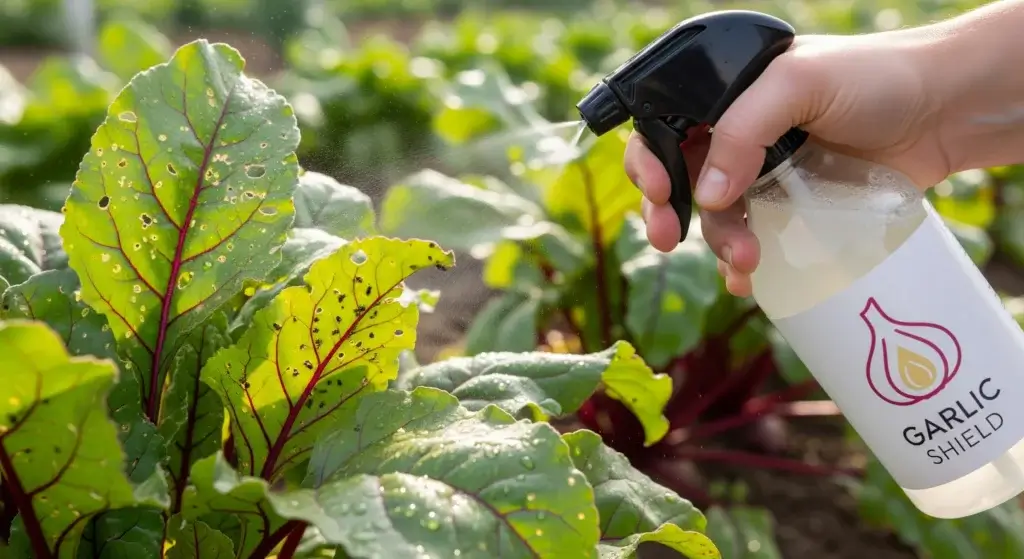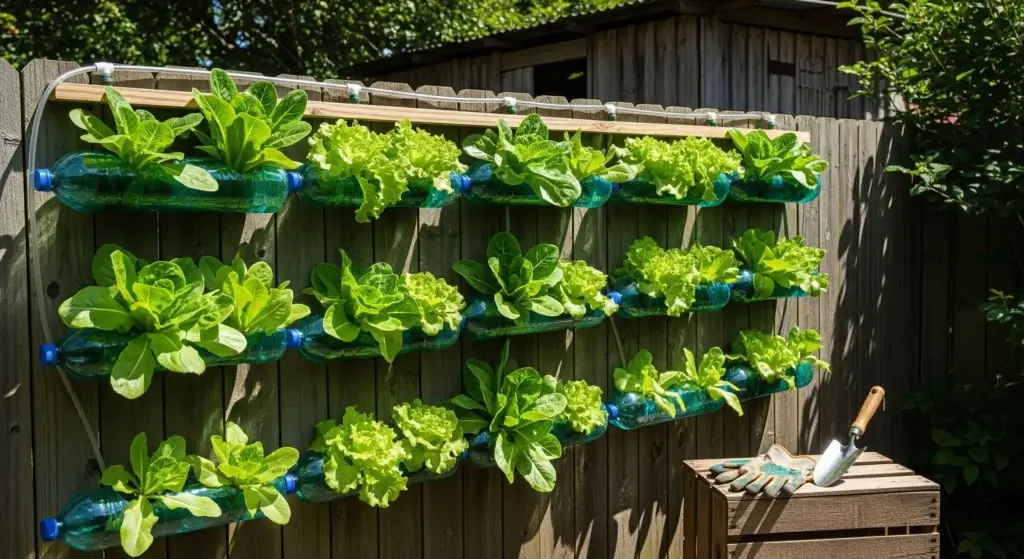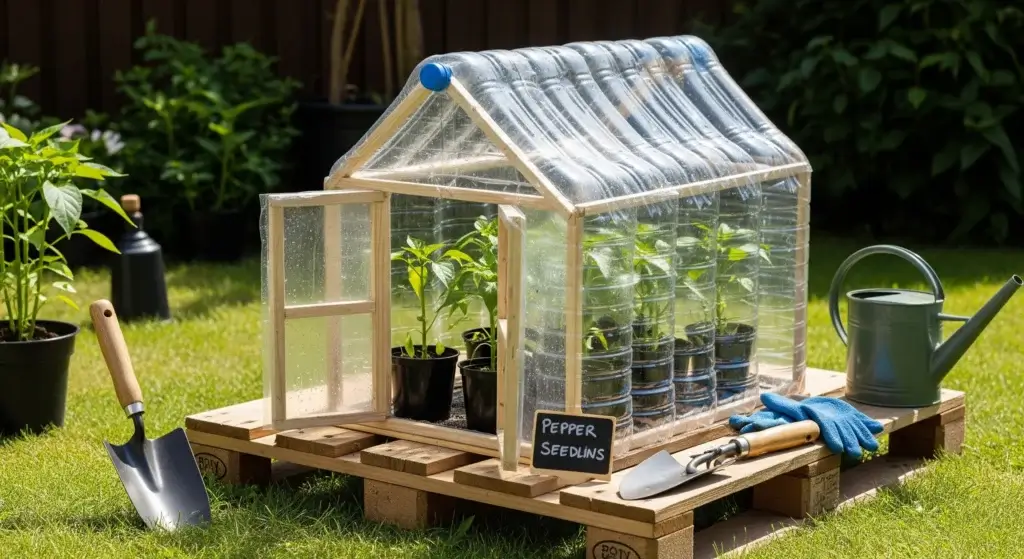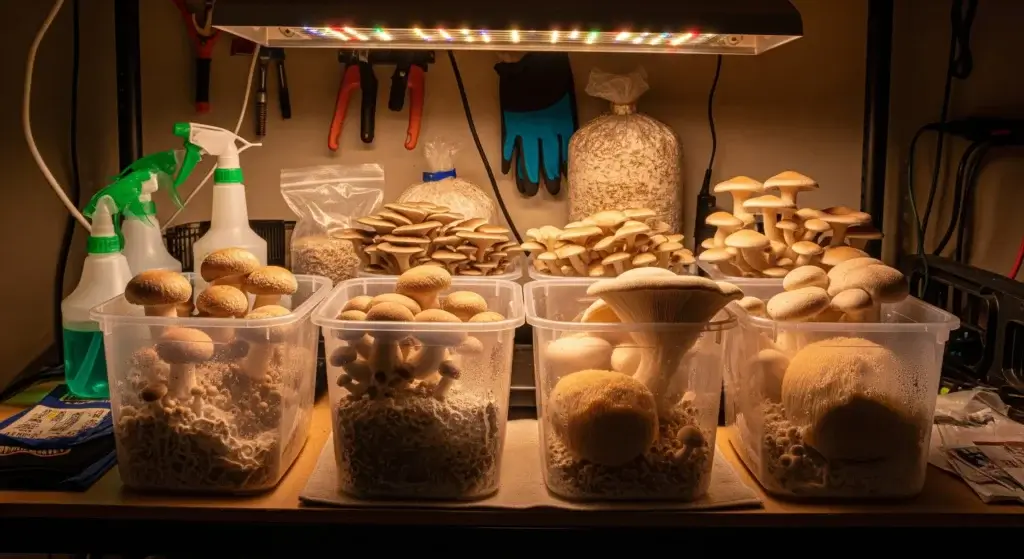Growing beetroot is honestly such a vibe—until aphids, leaf miners, and flea beetles pull up like uninvited guests at a house party and wreck everything. Chemicals can fix it fast, sure, but a lot of gardeners (including me back when I thought “organic” meant “tastes like dirt”) prefer something safer and way more eco-friendly. That’s where homemade garlic spray comes in. This stuff is ancient, cheap, and hits pests harder than your math teacher hits you with surprise quizzes.

Why Garlic Works as a Natural Pesticide
Garlic isn’t just for leveling up noodles—it’s been humanity’s secret weapon against pests since forever. When you crush it, it releases allicin, a sulfur-packed compound that smells so strong it could clear a room. Insects hate it even more than you hate group projects.
Spray it on beetroot leaves and it basically tells aphids, “Nah, not today.” It messes with how soft-bodied bugs eat, and bigger pests avoid it like it’s spoiled milk. Some studies even show garlic sprays can knock down aphid numbers by around 90% when used regularly. And the best part? It breaks down fast, so it protects your plants without leaving nasty chemicals behind.
Common Beetroot Pests That Garlic Spray Can Combat
Before you start mixing your garlic potion, it helps to know who’s been bullying your beetroots.
Aphids
These tiny freeloaders camp out under the leaves, slurping plant sap like it’s bubble tea. Garlic spray hits them hard—think of it like bug-level knockout gas—while its smell scares off backup troops.
Flea Beetles
These dudes leave your leaves looking like they were blasted with a mini shotgun. They don’t usually kill older plants, but they wreck seedlings fast. Garlic’s intense smell basically confuses them so badly they forget what plant they came for.
Leaf Miners
They draw squiggly graffiti tunnels inside the leaves, messing with the plant’s ability to make energy. Garlic spray makes adult flies rethink laying eggs there, breaking their whole cycle.
Caterpillars and Beetle Larvae
These are the crunchers—literally. They munch through foliage but hate the taste of garlic. Spray it on, and they peace out to find a tastier, less spicy buffet somewhere else.
The Basic Homemade Garlic Spray Recipe
You don’t need fancy gear or lab vibes to make garlic spray—just basic kitchen stuff and a little patience. This recipe gives you about a quart of concentrate, which you can stretch into multiple plant-saving sessions. It’s basically the DIY equivalent of unlocking a secret garden superpower.
Ingredients:
- One whole head of garlic (yeah, the entire thing—10–12 cloves)
- Two cups of water
- One teaspoon liquid dish soap (biodegradable and unscented if possible)
- Optional: One teaspoon vegetable or mineral oil
Equipment Needed:
- Blender or food processor
- Fine mesh strainer or cheesecloth
- Glass jar or lidded container for storage
- Spray bottle
Preparation Instructions:
- Start by peeling all those garlic cloves. Don’t stress about the tiny papery bits—garlic isn’t that picky, and the good stuff is inside the cloves anyway..
- Toss the peeled cloves into a blender with two cups of water. Blend it on high for one to two minutes until it’s fully liquefied. No chunky garlic soup allowed.
- Let the mixture steep for at least 12 hours, or overnight if you can. This step is non-negotiable—think of it like letting tea brew, but way stinkier.
- After steeping, strain everything through a fine mesh or a few layers of cheesecloth. This part matters, because spray bottles hate clogs.
- Add one teaspoon of dish soap to the strained garlic liquid. This helps the spray stick to the leaves and messes with pests’ protective coating.
- If you want extra stickiness and pest annoyance, add a teaspoon of oil now. It helps the spray cling to waxy leaves and adds an extra “nope” for insects.
- Pour your garlic concentrate into a clean glass jar and stash it in the fridge. It’ll stay effective for about a week. Yes, it will still smell intense.
How to Dilute and Apply Garlic Spray
Your garlic concentrate is basically the “extra spicy” version, and putting it straight on your plants would be like handing them a Carolina Reaper for breakfast—not ideal. So you’ve gotta dilute it.
Mix one part concentrate with ten parts water in your spray bottle. Shake it like you’re mixing the world’s worst salad dressing, because it separates fast.
Application Timing
Hit your plants in the early morning or late evening when the sun isn’t out here acting like a magnifying glass. Spraying in full sun can literally burn the leaves, and not in the cute drama-movie way.
Coverage is Key
Mist the whole plant, especially the undersides of leaves where pests like to gossip and hide. Use a fine mist—no swampy puddles, unless you want fungus gatecrashing your garden.
If you’ve already got a bug invasion, spray every two to three days until the problem chills out. For prevention, once a week is enough. And if it rains? Yep, you’re back out there respraying, because water washes everything away, including your garlic shield.
Best Practices and Important Considerations
Garlic spray is powerful, but like any strong tool, you’ve got to use it smartly if you want your plants thriving instead of throwing silent tantrums.
Always Test First
Pick one or two beet plants and give them a tiny preview spray. Wait 24 hours to see how they react. Some varieties act dramatic for no reason—kind of like that one classmate who says they’re “literally dying” after a single push-up.
Avoid Overuse
More garlic doesn’t mean more protection. If you drench your plants nonstop, they can get stressed, and your beet greens might even pick up a faint garlic flavor. That’s funny once, but not ideal for actual eating. Stick to weekly sprays for prevention or every two to three days when pests are being chaotic.
Consider Beneficial Insects
Not all bugs are villains. Ladybugs, lacewings, and other tiny garden heroes can get annoyed by garlic spray too. Aim to spray in the evening when they’re less active, and skip the flowers so you don’t bother pollinators. Think of it as respecting the night shift.
Rotate With Other Natural Solutions
Mix things up with neem oil or insecticidal soap every now and then. Pests can get used to one trick if you repeat it forever—kinda like how you stop noticing your sibling’s annoying habits after a while. Switching methods keeps your garden defense system sharp and sustainable.
Enhancing Your Garlic Spray with Other Natural Ingredients
Once you’ve mastered the basic garlic spray, you can level it up like you’re modding a video game potion. Little tweaks can make it way more powerful against stubborn pests or even help fight off fungi.
Hot Pepper Flakes or Cayenne
Toss in one to two teaspoons of dried pepper to give your spray some serious heat. This upgrade is for chewing insects that think your plants are an all-you-can-eat buffet. Just be careful—this stuff can sting your skin and eyes.
Onion
Garlic’s crime-fighting partner. Add half a chopped onion to the blender with your garlic, and you’ve basically created the Avengers of natural pest control. The combo smell alone could convince bugs to pack their bags.
Essential Oils
A few drops of peppermint, rosemary, or eucalyptus (10–15 per quart) turns your spray into the kind of scent that bugs absolutely hate. These oils also help with certain fungal issues. Plus, your garden ends up smelling like a spa that’s very, very anti-insect.
Integrating Garlic Spray into a Comprehensive Pest Management Strategy
Garlic spray is awesome, but it’s not a magic wand. Treat it like one tool in your garden toolbox — combine it with other good habits and your beetroot will actually stand a chance.
Companion Planting
Grow fragrant buddies like basil, cilantro, and dill next to your beets. They act like undercover bodyguards that confuse pests. Planting garlic or onions nearby is like setting up a garlic perimeter—bugs smell the vibe and walk the other way.
Crop rotation
Don’t plant beets in the same spot every year. Pests and diseases settle into a favorite neighborhood if you never move houses. Rotate with plants from different families to break their life cycles and keep your plot fresh.
Healthy Soil
Strong plants fight back better. Feed your soil compost, check pH sometimes, and make sure it drains well. It’s boring but powerful—kind of like giving your plants a gym membership and nutritious snacks.
Regular Monitoring
Look at your plants twice a week — check tops and undersides of leaves. Catching problems early means garlic spray actually works instead of playing catch-up with an all-out infestation. Spot one aphid and you’re already winning.
Physical Barriers
Use floating row covers or light netting for seedlings. They’re like tiny force fields that keep the first wave of pests out while your garlic spray and other tactics do the cleanup. Layering defenses = less drama later.
Conclusion: Embracing Natural Pest Control for Healthier Gardens
Garlic spray is basically the budget-friendly, eco-friendly superhero of beetroot protection. It keeps pests off your plants without dumping sketchy chemicals into your garden or onto your food. You’re literally using a kitchen ingredient to outsmart insects — that’s peak genius.
The recipe is simple, the ingredients are cheap, and it reliably pushes back pests like aphids, leaf miners, and flea beetles. When you combine it with other smart gardening habits, it becomes even stronger. Think of it as part of a whole strategy, not a solo act.



